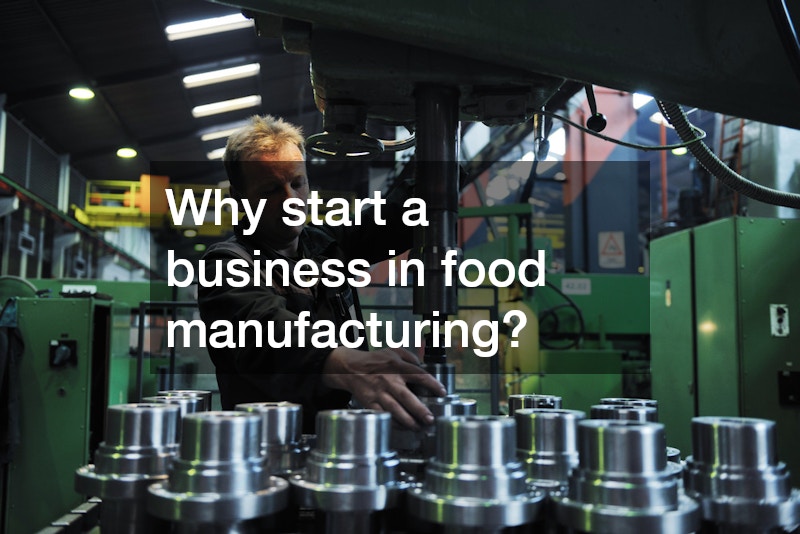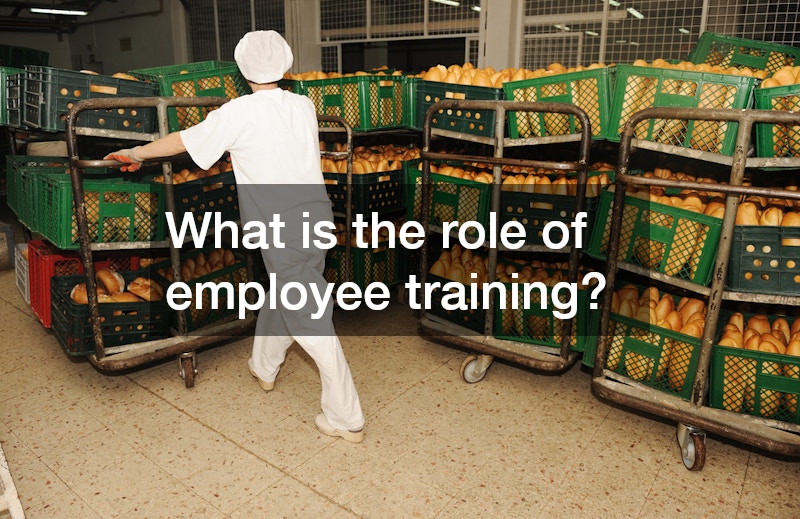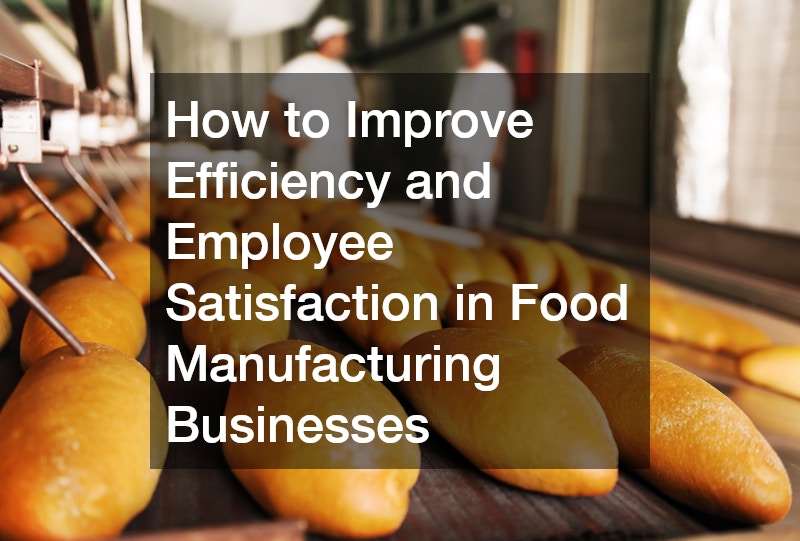How to Improve Efficiency and Employee Satisfaction in Food Manufacturing Businesses
Adopting different strategies, integrating new technologies and adhering best practices are all part of improving manufacturing processes. In this field, success is based on efficiency, productivity and quality control. We’ll explore the many facets of manufacturing. From streamlining production to ensuring clean spaces, all of these can have a significant impact on overall performance. Here is your food production business plan!
Why start a business in food manufacturing?

Food manufacturing is a lucrative business that offers many advantages and opportunities. Food manufacturing is a vital and resilient industry that provides consistent demand, even during economic downturns. Food products allow you to tap into a large market that is spread across multiple regions and demographics. This allows for diverse product offerings and the ability to cater to different tastes and dietary requirements.
A growing trend towards healthier, more sustainable food means that there is plenty of room for innovation. Entrepreneurs can develop unique products to meet the growing demand for organic or gluten-free options. They can also position themselves as leaders of niche markets.
Scalability is another advantage. You can start small and expand your operations over time as the demand grows. This will allow you to supply local restaurants, retailers or export products. The ability to control production ensures consistency in quality and can help build a brand over time.
Your food manufacturing business plan must allow you to be creative. This will let you create products that reflect your vision and values, whether they are promoting sustainability, supporting the local agriculture or introducing new flavors.
How can we streamline our production processes?
Adopting efficient manufacturing processes is a key to streamlining production. Lean manufacturing practices are an effective way to reduce waste and optimize workflows. This requires a thorough review of existing processes and the identification of areas for improvement.
Automation is also a key factor in streamlining the production. Manufacturers can increase production speed and reduce human error by integrating advanced technology and machinery. Robotics can, for example, handle repetitive tasks with precision.
Collaboration across departments can improve production efficiency. Communication and shared vision are key to solving problems in a creative way and adopting practices that reduce bottlenecks. The integration of these methods can be one of the most effective manufacturing solutions today.
What is the role of employee training?

Your food manufacturing plan must include employee training to ensure the efficient use of machinery and manufacturing parts. Well-trained employees can operate machinery safely and correctly. This reduces the risk of accidents. A comprehensive training program should include both theory and practical sessions.
Continuous education and upgrading of skills are also important. To maintain high levels of productivity, employees must stay up-to-date with new technologies and processes. This commitment to continuous learning can improve the quality of manufacturing processes.
By investing in employee training, you can create a culture that promotes competence and confidence. The job satisfaction of workers and their performance increase when they feel confident and equipped. This holistic approach aligns also with the overarching manufacturing goals.
What role does technology play in increasing efficiency?
The use of technology is essential to improving the efficiency of manufacturing. Integration of a point-of-sale system can streamline all operations, from inventory management to transactions with customers. This technology allows for the monitoring and optimization of every aspect of the business process.
Real-time data analytics are possible with advanced manufacturing technologies such as AI or IoT. These insights enable immediate adjustments to the processes, ensuring consistency and efficiency. These technologies enable predictive maintenance to further reduce downtime and increase equipment life.
Smart manufacturing includes the use of UV equipment manufacturing services to maintain a sanitized environment in production. These technologies are not only efficient but also adhere to health and safety regulations. They reflect a commitment to high standards in the industry.
What are the best practices in supply chain management?
Your food manufacturing business plan should include a strategy for effective supply chain management. This is essential to maintaining smooth manufacturing operations. Integrating advanced software solutions is a best practice for monitoring and managing every aspect of your supply chain. This real-time monitoring helps anticipate issues before they become major problems.
It is important to build strong relationships with your suppliers. Communication channels that are reliable ensure minimal disruptions and timely delivery of materials and manufacturing components. A coordinated supply chain can reduce costs and lead times.
Just-in-time inventory management (JIT) is another option. This method minimizes holding costs while ensuring that the materials are always available when required. These strategies can improve the efficiency of manufacturing and reduce waste.
What is the impact of workplace culture on employee satisfaction?
Positive workplace cultures are key to retaining and attracting employees. It is important to create an environment in which employees feel appreciated and recognized for their contributions. This atmosphere promotes motivation and ownership.
Another important aspect is to provide opportunities for professional development and growth. Employees’ engagement and commitment increase when they see a clear pathway for advancement. When companies invest in the future of their employees, they often see higher productivity and more loyalty.
The workplace culture should also encourage open communication and collaborative work. Employees who feel heard will promote a cohesive and supportive work environment. These elements are fundamental to creating an environment that meets and exceeds operational goals.
What are the most effective strategies to achieve environmental sustainability?
Your business plan for food production is becoming more and more environmentally sustainable. Recycling and reusing of materials is an effective way to reduce waste. This will reduce the environmental impact of the production process.
Another important strategy is to invest in energy-efficient technology. Water heaters that are energy efficient can reduce energy consumption and costs for businesses. Solar power and other renewable sources of energy can also help to enhance sustainability.
Partnering with eco-friendly providers is also part of a sustainable practice. Using food transport services with green logistics will ensure that the entire supply chain supports environmental goals. These practices can not only improve the environment but also the reputation of the company.
How can you maintain quality control?
In the food industry it is vital to maintain quality control. This involves meticulous monitoring and inspection. Regular audits, as well as the use of modern testing equipment, are required to maintain high standards. Your food manufacturing business plan should include robust quality control protocols to ensure all products are safe and meet quality standards.
In the food industry, it is crucial to maintain strict quality control. To avoid contamination, welding processes should be performed in a sanitized environment. Inspection of welded joints is necessary to prevent failures.
Automating and using real-time monitoring can improve quality control. A real-time tracking system for quality helps to identify defects early and take corrective actions promptly. These practices are essential for maintaining the standards of manufacturing solutions.
How can we effectively manage our finances?
Achieving efficient financial management in manufacturing requires strategic planning and careful tracking of expenditures. A robust accounting system will ensure accurate tracking and reporting of financial data. It is the basis for making well-informed business decisions and maintaining good financial health.
Businesses make a large investment in water heaters. Energy-efficient models will save you money in the long term. The financial management process should evaluate such investments in order to maximize operational costs while maintaining quality.
Accounting for business taxes is another key area. Expertise is required to maximize deductions while remaining compliant with the tax regulations. Tax accounting can be outsourced to ensure compliance and financial optimization. These practices are essential to sustainable financial management.
What are the legal implications of food manufacturing?
Food manufacturing is subject to strict regulations that ensure quality and safety. The Food Safety Modernization Act, for example, is a law that cannot be negotiated. If you fail to follow your business plan for food manufacturing, it can lead to severe penalties and damage to your brand.
Labeling and documentation must also meet legal requirements. Labeling accurately ensures all information is clearly communicated to the consumer, including expiration dates and ingredients. Maintaining detailed records is important for traceability and accountability in the event of a product recall.
Another important legal consideration is the protection of intellectual property (IP). Patents, trade secrets, and trademarks protect manufacturing processes and products against unauthorized use. This legal protection helps to ensure that innovations are a competitive edge and encourages investment in R&D.
What are the market trends?
In the manufacturing industry, it is important to stay abreast of current market trends. Analyzing consumer preferences and behavior can help inform marketing and product development strategies. This proactive approach will ensure that the company is able to meet market demand effectively.
The market is being transformed by technological advancements such as digital insurance store solutions. Adopting new technologies can give you a competitive advantage, including improved customer service and streamlined operations. Keep an eye on the latest technological trends to improve your business.
Analyzing data and industry reports can give you insights into new trends. This information can be used to make strategic decisions in line with market trends. These practices will ensure that your company is agile and ready to take advantage of new opportunities.
How can we maintain a sanitized environment?
To prevent contamination, it is important to maintain sanitized areas as part of your business plan. UV equipment manufacturing services are an effective way to kill pathogens. Implementing these technologies will ensure a higher level of hygiene.
It is important to establish and adhere to regular cleaning and disinfection procedures. The production environment is kept safe and sanitized by using food-grade cleaning products and adhering industry standards. These practices are essential to compliance and quality control.
It is also important to educate employees about proper sanitation practices. By ensuring that all employees understand and adhere to protocols, the risk of contamination is reduced. It is important to maintain a sanitized and well-maintained manufacturing environment in order to produce high-quality products while maintaining safety standards.
What services should we outsource to?
Outsourcing services can improve efficiency and help you focus on your business plan. Business tax accounting, for example, is a highly specialized field that requires expert knowledge. Outsourcing ensures that tax laws are followed and financial management is optimized.
Outsourcing can also be used for the creation and design of specific components, for example, by engaging a designer of plastic preforms for specialized parts. The company can leverage external expertise and focus on its core competencies. Outsourcing can result in cost savings and better quality.
Outsourcing is also possible for technical services such as IT support, maintenance, and management. It is possible to implement and maintain the latest technology without needing in-house expertise. Strategic outsourcing allows for the most efficient use of resources and helps achieve business goals.
How do we find the best designers to hire?
A strategic approach is required to hire the best designers. The first step is to identify the skills and expertise required for a role like a designer of plastic preforms. Job descriptions and clear requirements will help you attract the best candidates.
Using multiple recruitment channels such as online job sites and professional networks can help to expand the talent pool. By participating in industry-specific forums or events, you can connect with talented designers. These methods can be combined to increase the likelihood of finding top talent.
Offer competitive compensation packages and growth opportunities to attract the best designers. The company’s commitment to employee welfare is demonstrated by a comprehensive package that includes benefits from a digital store of insurance. This holistic approach ensures the best designers not only get hired but also stay.
What kind of employee benefits should we offer our employees?
When creating your business plan, it is important to offer competitive employee packages in order to attract and retain top talent. These packages should include comprehensive benefits such as retirement plans and wellness programs. Working with an online insurance store to provide employees with tailored insurance solutions is a great way to meet their needs.
Flexible work arrangements such as flexible hours and remote work can increase job satisfaction. These benefits can improve the work-life integration by catering to different lifestyles. Customizing employee benefits to meet different needs can promote a positive work culture.
Employee packages should include professional development opportunities. Access to training programs and certifications as well as career advancement paths can help in the enhancement of skills and growth. These packages are designed to make employees feel valued in their career journey.
A multifaceted approach is required to improve manufacturing processes. This includes integrating technology and best practices with a focus on employee satisfaction. Include these elements in your business plan for food manufacturing!
